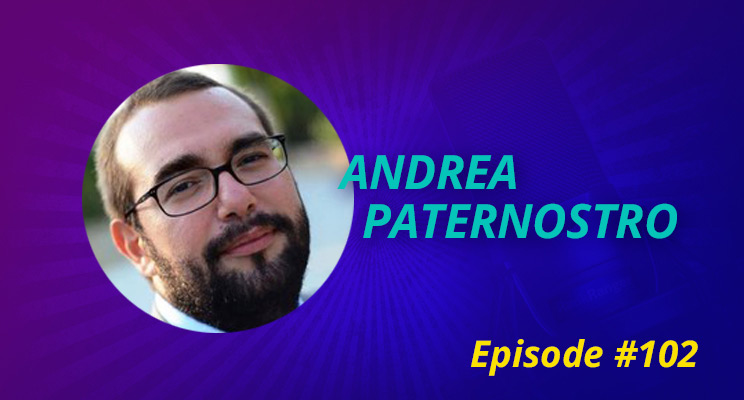
Posted by
The In Search SEO Podcast
Does your B2B blog bring your site a steady stream of organic traffic? Is the content that you publish underpinned by a premeditated SEO strategy?
In episode #101 of the In Search SEO podcast Andrea Paternostro explains 5 steps to turn your B2B blog into an SEO machine.
The steps are:
- Absorb
- Plan your content
- Execute
- Reach
- Analyze and restart
We’ll be discussing B2B blog strategy today with a man who’s a professor of digital technology at SAE Institute Milan. An SEO trainer at Job Farm, and SEO and publisher at Milano Weekend. He’s also SEO and webmaster at B2B software house, Irion. A warm welcome to the In Search SEO podcast, Andrea Paternostro.
B2B Blog Strategy in 5 Steps
Andrea: Hello, everyone. Good to be here, David.
D: It’s good to have you here. You can find Andrea over at milanoweekend.it. So Andrea, is it still important for every B2B brand to have a blog?
A: I could say it depends, as any SEO consultant would say. I have some steps for good content lifecycle management that could convince you that it’s a good choice for your brand. I work in a B2B brand software house, which has a very complex software product to sell. And we struggle, of course, to do a lot of competitive intelligence, and to understand our market. I will say that it is important to build a strong brand. And the CEO could be an amplifier of it. But if you don’t have a good brand, it would be very difficult to do search engine marketing, overall.
D: Understood. Okay. Essentially you’re saying that B2B blogs are very important. However, you absolutely need to get your brand right before even thinking of having a blog.
A: You can’t only rely on the corporate blog for your strategy throughout all the stages of the marketing funnel. But if you are good at managing the funnel in the first stage, the attention, the consideration of the potential client or customer, then your salespeople will have a qualified contact and the people are attracted by quality content that maybe they ****, they are willing to download the white papers and other B2B material that will be very useful to drive sales.
Anything that starts with the absorb phase, as I call it. I’m a journalist, I have spent many years of the first part of my career in journalism. So I started out to conduct an interview. And the quality of the interview that you conduct with your internal or external customers is great to prove alignment with your business needs. If you know what to ask your top manager or your customer, then you can do very good keyword research because you end off this interview with a lot of business-aligned material.
D: In your opinion, what stage does a B2B blog fit into the customer acquisition funnel? Is it very early on? Is it the acquisition phase? Or is it later on when someone’s heard of your brand, but you’re warming them up in order to become a customer?
A: The early one is very important and I’m reminded that Google calls today the customer journey, the messy middle. So between the stimulus, the people navigating on the internet on their laptop, and the salespeople making an offer and driving a sale, there’s a lot of effort that you have to do. There are a lot of stages. It maybe could pass some months before people buy your product. So the early stage is fundamental, because people get in touch with your brand with the quality content. For example, an informative research intent today in B2B is so important because you answer to complex questions. And also remember that Google has put a People Also Ask section in the modern results pages. The People Also Ask section means that we have to respond to precise questions.
D: You already touched upon your number one point of the five steps to turn your B2B blog into an SEO machine and that was to absorb. Can you give us a very brief summary of that absorb process again?
Step 1. Absorb – Understanding the Context of Your Blog
A: Yes, for example, there are some action items that you can use. We use the page review triggers. These triggers are selling priorities, for example, which is a market-driven point, or product vision. So if you have a good relationship with your board, your top management, you are aligned with their vision. This is a very important treatment of Content Review. Content Review means that you modify existing content. And you’ll often get a quick win rather than creating new content, which is a bit harder effort. Another point is customer journey analysis. Because if you perform a good analysis of this at this stage, you know how to plan your content better. And competitor benchmarking because there are some quick wins that can give you a vision about what competitors are doing. Let’s think about the Site Operator in Google, which is a very quick operator but can let you know what has been indexed by the competitors, in some seconds.
D: Understood. So it’s absorbing the context of where your blog fits into the overall picture. And that includes your overall business strategy, what your executives are trying to achieve, what content you have already, just to ensure that strategically, the content that you intend to publish is as effective as possible.
A: Yes. You know that there are five content management actions on every content. We may choose to write new content, add to an existing one, increase internal linking, external linking, or try to drive a backlink to the content. This is my checklist when I need to choose an action about editing or new. And if editing, what I need to do. I need to add the paragraph because I perform better in the keyword search. Maybe I talk with my boss or with the board. And I know that the product vision has changed. Because the market changes rapidly and you add the features to your software product, for example. And most of the time you don’t need to write in your content to align the website to the business vision. You just need to add the paragraph if you already have a good structure and you can modify an existing page.
D: Those are some great additional steps in terms of how you can define the purpose of your content. But number two of your steps to actually turn your B2B blog into an SEO machine that is to plan.
Step 2. Plan Your Content
A: Planning means you should prototype faster. Why prototype? Because we need to absorb some good practice from the Agile Project Management way of work. You need to write less about what you’re doing and do more, the Agile framework as it works. In the past, especially tech people, but not only tech people, wrote large manuals and a lot of pages about the product. Now, for example, I get a lot of insight by developing a side project for the recycling of the support website of my company, Eden. By redesigning the knowledge base, I transform the old domain, all the style legacy format of documents into a fresh WordPress installation. A fresh website, which is quick and easy to navigate. It has a table of contents, it has breadcrumbs, it has a lot of things to ease the life of the visitor. This is everything that you can do to ease the life of your customers and get them more satisfied through content and the quicker content reviews aligned with your top management.
D: You mentioned WordPress there. What are maybe one or two plugins that you are a big fan of that will really help to optimize the content that you’re publishing?
A: It depends on the project. But I have my stack, of course, and stack analysis is important because you need to save time. You need to understand what competitors are using and to save time and build your technology stack as fast as possible in order to concentrate on your product. For example, I am quite a fan of Easy Table of Contents, because it creates fastly, quickly, and for free a summary of the content. And if the content is more than 700-800 words, it is necessary to drive the attention of the visitor through a summary. A summary is very important and also has the SEO benefit of being very understandable by Google who knows the structure.
For example, at Milano Weekend, we have featured content, in which every Thursday, we present the events and the things to do in Milan. And we always create a summary. Google has a perfect knowledge of what we are doing and the timing of when we are publishing the content. And in a keyword for a query, for example, like events in Milano, every Thursday, we jump into the first places of the search engine results page, which is very curious if you think because Google has learned how to change its search results every week, depending on the time of recording content that we publish and organize.
D: Do you write your summaries in a certain format in order to encourage Google to feature a Rich Snippet?
A: Of course, I think it is the most important optimization factor on-page relating to the necessity to talk to users when articles are in long-form. When articles are more than 100 words in length, you need to drive the attention of people because you can’t imagine that people will scroll through everything. So you need the HTML anchors, which are given via the summary with internal links. And you need to write the titles very well. They should be catchy, but it is better, of course, if they contain some form of the query of the user.
D: And number three of your steps is to execute.
Step 3: Execute – Creating Your Content
A: Yes, and that is my **** for WordPress. Because CMS, you need to go vertical on CMS. I have gone vertical in the last 10 years on WordPress. You need to strike, for example, the right balance between the quality of visual resources and the size of the file just to ensure better page loading. There’s a lot to do in page optimization and a lot to do with the Core Web Vitals. These new parameters by Google are very important and you should avoid above all the layout to shift that could happen if you don’t know how to optimize some part of the page. This is the most technical work. But for good execution in SEO, you need a great team.
For example, my Irion marketing team, my colleagues, which are creative people, started on graphic and the visual communication branding, but they are willing to learn how to use a CMS. So WordPress is quite simple to use. But there is always something to learn. For example, how to learn a page builder, because hardly ever you can write everything in HTML. In a faster pace in the content marketing team, you often need a page builder and you, therefore, need to learn how to use it.
D: And that takes us up to step four which is reach.
Step 4: Reach – How to Best Reach Your Target Audience
A: This is very important whether it’s reach, distribution, or spread, whatever you may want to say. But the important thing is that today a company or corporation has so many digital channels to manage. So how do you strike a balance? Even here, in this case, this CRM, for example, this CRM may help you a lot, because the consumer relationship management software could give you a conditional navigation path depending on which kind of person is entering your website. This is quite a sophisticated form of automation if we will think that is a new topic in the market, but it’s gaining so much attention by marketers. For example, you sent me a link to a previous recording here. And the colleague aside, the automation was there, the Pareto Pickle. I’ve chosen one but I’ve been forced to.
D: And that takes us up to step number five, which is analyze and restart.
Step 5: Analyze and Restart
A: My advice is to quantify your content lifecycle team effort, which means in order to speak with your top management, with your board, you need the internal sponsorship by managers about the budget in time and then resources for your marketing and content team. So how do you get into the sponsorship? By letting them know that you are quantifying, you are measuring how much time a piece of content is worth for better production. And all the time of the people involved is necessary to track because it is a good way to talk with your CEO or other stakeholders.
My second piece of advice is don’t to report too much. Instead, give insights. It is quite unuseful today to write too many longer reports. It is better to synthesize and summarize trying to give insight and visualize information. The traditional reporting structure is maybe unfit for this everything moves so fast period that we are living in.
D: I **** the advice there especially your second tip there as a lot of SEOs get passionate about so many different metrics. But of course, most of the companies don’t know what they’re talking about and get turned off by that quickly. But your first point was about actually sharing certain metrics with people is important as well. Because if you can share how many page views or how many people discovered someone’s article, that’ll get them hopefully excited about writing more articles in the future. So just share the right metrics and that could be very effective for you.
The Pareto Pickle – Competitive Intelligence
Let’s move on to the Pareto Pickle. Pareto says that you can get 80% of your results from 20% of your efforts. What’s one SEO activity you would recommend that provides incredible results for modest levels of effort?
A: I like to say my Pareto Pickle is competitive intelligence because we perform so many tests on-page. And we have little time to see elsewhere. But this is so important. And there are some quick wins, like Google operators, to see pages indexed by other websites or tools, which gave, for example, time machines, which keyword ever had a better ranking of the competitor or a lower ranking in a certain period of let’s say, the last six months. And my direct competitor, how did they perform? What has gone well or bad for them? Also the martech stack analysis. You should always perform analysis on the stack that people use on their website, especially if they have a success. So you should try to perform reverse engineering on what people use for their website. For me, the analysis of competitors is something that takes a few hours a week but gives so many insights.
D: Yeah. And I guess giving more feedback to other people within your organization as well as to what your competitors are doing and hopefully giving them some tips as well. Not necessarily directly in relation to SEO but your whole martech stack. If you can give an indication as to maybe what a competitor is using it for. Perhaps some kind of chats online or something else that’s certainly keeping up with them and hopefully bettering them in the future. But I’m not going to go down that rabbit hole too much there. I’m just going to say that I’m your host, David Bain. Andrea, thanks so much for being on the In Search SEO podcast.
A: Thank you, David. It’s been a pleasure.
D: And thank you for listening.




